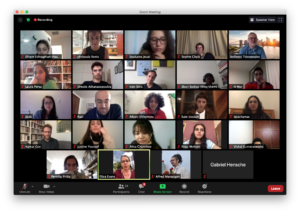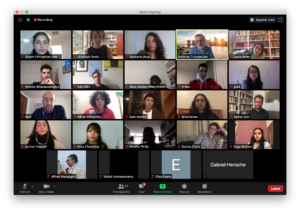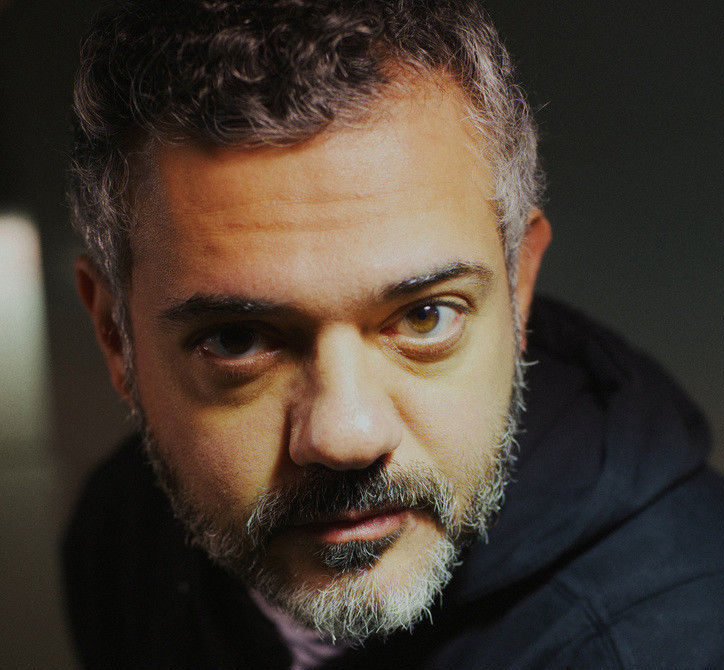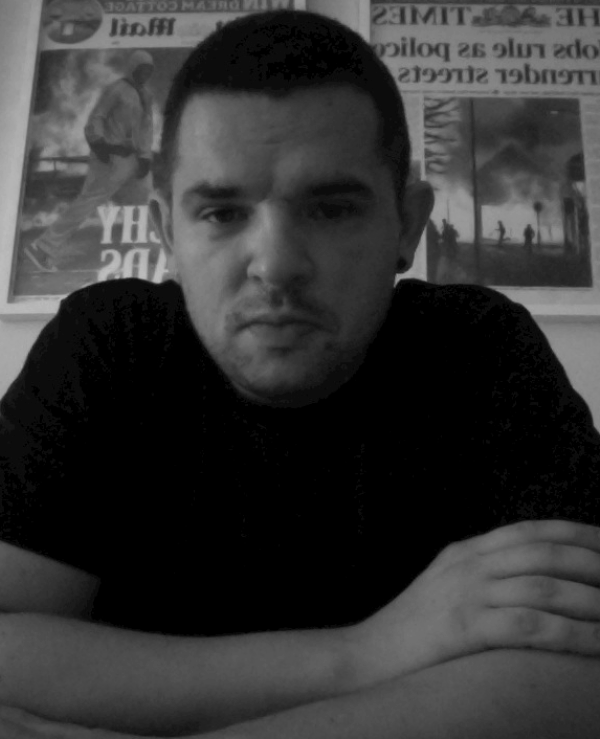One on One: Stefanos Tsivopoulos and Chrisoula Lionis, Artists for Artists
The “One on One” series presents timely encounters between ARTMargins Online editors and contemporary artists, usually focused on one recent work. In this installment, Uroš Čvoro talks with interdisciplinary artist, filmmaker, and educator Stefanos Tsivopoulos and curator and cultural producer Chrisoula Lionis about Artists for Artists (AfA), an online pedagogical platform that connects leading artists with early career artists from around the world.
Uroš Čvoro: Artists for Artists (AfA) is based on three principles: artists for artists, peer-to-peer, and radical care. Can you provide a brief overview of the project, and how these ideas inform it?
Stefanos Tsivopoulos: AfA is an online pedagogical program that operates under the framework and ethos of radical care, which means it is focused on care, solidarity, and the creation of a safe space for early-career artists who participate in specially curated lectures and workshops. Emerging artists (the AfA section Participating Artists) and more established artists (AfA Advising Artists) come together for three days and exchange experiences, knowledge, and ideas about developing their practice. AfA’s peer-to-peer principle came out of the need to generate a self-sustaining artistic support model in these times of extreme precarity. Given that AfA does not rely on institutional support, the question was: how could this autonomous self-sustainable program provide micro-funding for some of the artists? We came up with the idea of peer-to-peer funding. All participants contribute a small amount ($50 per person), which the AfA Participating Artists then distribute to the same three fellow artists. Peer-to-peer micro-funding is a system that provides an incentive, but also inspires artists’ commitment to generosity and solidarity towards their peers.
Chrisoula Lionis: As we were having conversations about terminology, “radical care” emerged as the term that best described our ethos and praxis, one outlined by Tamara Kneese and Hi‘ilei Julia Kawehipuaakahaopulani Hobart, who use the term to describe non-hierarchical collective work in the age of compounding emergencies.(Hobart, Hi‘ilei Julia Kawehipuaakahaopulani, and Tamara Kneese. “Radical Care: Survival Strategies for Uncertain Times,” Social Text 38, no.1 (142) (2020), pp. 1-16.) The second thing was how nonhierarchical and autonomous care work has been increasingly instrumentalized by various institutions. For us, it was very important that our participants understand that AfA operates transparently: we were explicit about the fact that no one is being paid (neither the organizers nor the advising artists), and AfA is a pilot program and an experimental model we are developing and building. The combination of this theoretical framing and our praxis of radical care resonated with both the Advising and Participating Artists. We were very moved by how deep a chord this has struck, and how Participating Artists wanted to continue collaborating with us as we move toward our second AfA masterclass edition.

Artists for Artists inaugural Masterclass “Meet and Greet” session. July 16 2020. Screenshot.
UČ: The first iteration of AfA finished in July 2020. What was your experience and that of the participants?
ST: I would say that artistic and cultural institutions’ support and help towards the global artistic community were underwhelming and deepened the precarity in which we create art. Especially the lack of funding, the lack of support—notably for early-career artists—has been extremely disappointing. Artists in many parts of the world are still isolated, receive no funding, are unable to exhibit, and lack meaningful discourse. Often that leads them to doubt or debate the very essence of their artistic process. So AfA was conceived and developed as a response to this state of emergency. Our intention to create a safe space for artists to share their work and meaningfully address some of the issues they face resonated with many participants. The feedback is humbling. This has been the most rewarding aspect of AfA so far.
CL: The global reach of AfA was quite surprising. When we did the open call, we received applications from 30 different countries. In the end, this AfA masterclass edition consisted of 24 Participating Artists, divided according to theoretical approach and practice into three workshop groups led by our AfA Advising Artists Terike Haapoja, Ahmet Öğüt, and Stefanos Tsivopoulos. We worked with a generation of international, early-career artists who are engaging with similar themes in very different geographies and backgrounds. These artists came from 17 cities ranging from Bangalore, Santiago, New York, Melbourne, Manila, and Fez. The strong presence of participants from the Global South was particularly significant for us, as it did not replay the structural inequalities of representation in major institutions.
UČ: Stefanos, what is the relationship between this project and your earlier work? Here I am thinking especially about your History Zero (2013), which also addressed alternative economies of exchange.
ST: The project was initially conceived as a continuation of topics such as alternative economic models, participatory forms of knowledge production, and methods of cultural and historic unlearning. I investigated some of these ideas previously in works like History Zero (Venice Biennale, 2013), Borrowed Knowledge (ISCP, 2011), and the Precarious Archive (documenta 14, Kassel, 2017). Many ideas about AfA’s peer-to-peer micro-funding sprung from the research I conducted on alternative economic models for Alternative Currencies: An Archive and A Manifesto, a collateral project of History Zero. It is an assemblage of texts and images that explores how communities have purposefully created their currencies independent of state or crown. The archive’s stories, texts, and images are gathered from community organizations, ethnographic accounts, alternative financial institutions, NGOs, economic studies, and historical sources. The project developed as a critique of the inequalities that our financial systems create through their structures and follows up on that critique with a vision of more ethical, sustainable, just, and socially embedded exchanges that provide us with new ways to relate to each other and the world around us. Peer-to-peer exchange is one of the most accessible and easily customizable exchange models used by many communities because it directly serves a community’s particular needs. Most peer-to-peer models are micro-ecosystems that run parallel to the mainstream currency and economic infrastructures, but offer immense monetary relief based on social bonding. By implementing an economic component in AfA’s infrastructure, we wanted to raise the importance of economic issues in the arts and underline that artists can rely on communal responsibility and do not need to rely on institutions. In a way, the economy is part of AfA’s pedagogical model.

Stefanos Tsivopoulos, Alternative Economies: An Archive and A Manifesto. 2019. Video, photography, text, performance, architectural installation. Rubin Foundation New York. Image Courtesy of the Artist
UČ: Another important aspect of AfA is the notion of infrastructure building. Can you talk about that?
CL: The term “artist as infrastructure builder” was coined as part of project at the National Institute for Experimental Arts (UNSW Australia), which focused on artists who use their practice as a means of creating new infrastructures, rather than one-off socially engaged art projects that fall away after an artist departs. An example is Khaled Hourani’s Picasso in Palestine project – a single artwork that generated a museological infrastructure in its wake.
I’d like here to return to Stefanos’ point about History Zero as an ongoing and evolving project; this is important because AfA was initially conceived as an artwork that built upon the decade of work and research he has conducted into alternative systems of exchange. Beginning as a singular artwork geared toward developing a new pedagogical and funding infrastructure, AfA is demonstrative of the concept of artist as infrastructure builder. Importantly, I should note that there is a difference between creating infrastructure and replicating institutional practice. We appreciate that many structures in the global art world are under serious pressure, and this impacts early career artists disproportionately. With AfA, we aim at developing a new system and don’t want to replicate the problems that already exist, namely the structural disadvantage that marks art education. This often excludes early career artists (particularly from the Global South) from mentorship, network building, and career development. If we are looking at the outcomes of online pedagogical models that have sprung up during COVID, there are two things you will notice. One, we can see a form of education fatigue, the result of pressuring artists to be “productive” in the middle of a pandemic. Two, some of the alternative models being built are starting to replicate the issues of disenfranchisement we identify with major educational institutions, particularly in terms of charging considerable amounts of money. We need new models that are more equitable, agile, experimental, more transparent. Artists are best placed to develop these models. They know what other artists need, and they are nimble infrastructure builders because they’re exceptionally well versed in negotiating precarity.

Artists for Artists inaugural Masterclass “Meet and Greet” session. July 16 2020. Screenshot.
UČ: What are the next steps for AfA?
ST: We’re working on a series of upcoming events together with the Participating Artists from the inaugural edition. One is a series of online residencies focused on disparate geographies that will result in online presentations and live events accessible to the broader public. A significant step is the first exhibition of AfA participants curated by Abhijan Toto (director of the Forest Curriculum and curator of the Moscow Biennial for Young Art). And we are also working on the next edition of the AfA Masterclass at the end of November 2020. The call will be announced in early October on our website. We’re also excited about the first physical edition of the AfA Masterclass that will take place in Athens in Summer 2021. It will have a renewed focus on the regional art scene, aiming to collaborate and bring together artists from South-Eastern Europe and North Africa.
For more information about AfA, please go to https://www.afamasterclass.org/about
This interview was conducted via Zoom in September 2020. It has been transcribed and lightly edited for brevity and clarity.







